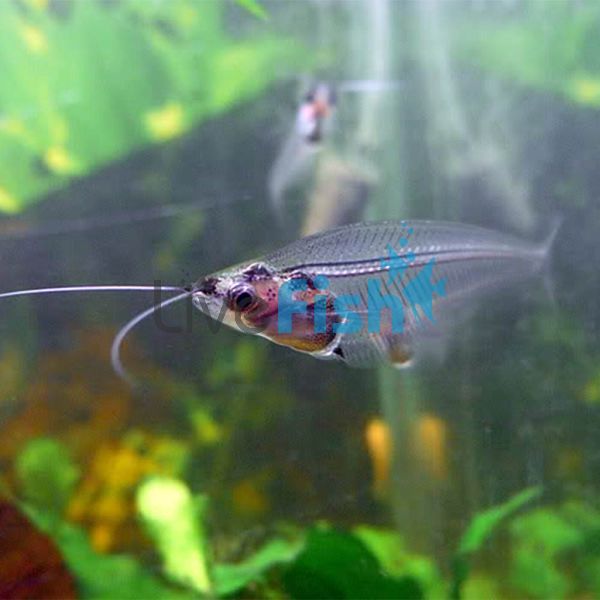Phantom Glass Catfish 4cm
It is still quite hard to comprehend that a totally see-through fish exists and is easily available to be kept in the aquarium hobby. The phantom glass catfish truly is an oddball species that looks like it came out from the deep sea. This however is a fully freshwater catfish species that has a fully transparent body and actually spends a lot of its time out in the open once it settles into the aquarium.
Phantom Glass Catfish
It is still quite hard to comprehend that a totally see-through fish exists and is easily available to be kept in the aquarium hobby. The phantom glass catfish truly is an oddball species that looks like it came out from the deep sea. This however is a fully freshwater catfish species that has a fully transparent body and actually spends a lot of its time out in the open once it settles into the aquarium.
Phantom glass catfish have a really thin but long body shape. They are quite unlike other catfish species as they spend most of their time in the mid-water column but also have really unique physical features. These are species that totally lack a dorsal fin, they can reach a length of 12 cm but all of their fins are on the bottom half of the body. The organs of this fish are basically compressed into the first 3 - 4 cm of their body and the rest is just clear to the point you can see right through them. The entire bone structure of the glass catfish is visible and their body actually does have this slight translucent colour with iridescent skin. Under very precise lighting conditions these fish reflect a rainbow of colours from their back almost looking like the aurora borealis. Like classic catfish, this species also has long whiskers that can often reach 6 cm long.
Breeding these fish in captivity has been seen before however there does not seem to be much success raising the fry. Along with this, it is very uncommon for glass catfish to show signs of breeding at all. Glass catfish are naturally found in the calm waters of Thailand and Malaysia.
Tank Recommendations for your Phantom Glass Catfish
Though the glass catfish can reach lengths of 10 - 12 cm it is better that they are kept in smaller, calm aquariums because of how these fish live in the wild. The minimum tank size for a school of glass catfish is 70 liters and it is recommended to keep a minimum of 3 fish.
Giving these fish a will planted aquarium would be great as it provides cover and breaks up the flow in the aquarium. They will however also do well in a blackwater aquarium as long as there is a cover for them to hide if required. they are mostly mid to top water-dwelling fish so the choice of substrate and aquarium hardscape is not a major concern. The glass catfish is a tropical fish that are best kept at 24-26 degrees.
Suitable Tank Buddies
The glass catfish really does need a proper selection of tank mates as they can very easily be stressed out or be outcompeted by fast tank mates.
Usually Compatible
Bristlenose plecos, borneo loaches, Khuli loaches, celestial pearl danios, emerald eye raspboras, and similar slow and species.
Sometimes Compatible
Angelfish, black widow tetras, Apistogramma, giant danios, and other fast-moving species could outcompete the glass catfish
Rarely Compatible
Tiger barbs, convict cichlids, red tail sharks, and any fin nipping or aggressive species could easily stress the phantom glass catfish out.
Feeding your Phantom Glass Catfish
Phantom glass catfish should take a wide range of pellets, flakes, and frozen foods. Giving them a varied diet ensures that they have optimal nutrition. The ideal diet would be a good quality slow sinking food, supplemented with frozen bloodworms or black worms or even live foods like baby brine shrimp or micro worms.
| Scientific Name | Kryptopterus bicirrhis |
|---|---|
| Care Level | Hard |
| Common Names | Glass Catfish, phantom glass catfish, skeleton glass catfish |
| Diet | Omnivore |
| Fish Family | Siluridae |
| Lifespan (years) | 8 |
| Max. Length (cm) | 12 |
| Min. Tank Volume (l) | 70 Liters |
| Origin | Thailand & Malaysia |
| Reef Safe | Yes |
| Sociability | Peaceful |
| Venomous | No |
| Water Conditions | 24-26° C, pH 6.0-7.0 |




